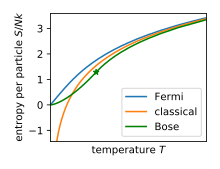Sackur–Tetrode equation
The Sackur–Tetrode equation is an expression for the entropy of a monatomic classical ideal gas which incorporates quantum considerations.
The Sackur–Tetrode equation is named for Hugo Martin Tetrode[1] (1895–1931) and Otto Sackur[2] (1880–1914), who developed it independently as a solution of Boltzmann's gas statistics and entropy equations, at about the same time in 1912.
Formula
The Sackur–Tetrode equation is this:
where V is the volume of the gas, N is the number of particles in the gas, U is the internal energy of the gas, k is Boltzmann's constant, m is the mass of a gas particle, h is Planck's constant, and ln is the natural logarithm. For a derivation of the Sackur–Tetrode equation, see the Gibbs paradox. For the constraints placed upon the entropy of an ideal gas by thermodynamics alone, see the ideal gas article.
The Sackur–Tetrode equation can also be conveniently expressed in terms of the thermal wavelength .
Note that the assumption was made that the gas is in the classical regime, and is described by Maxwell–Boltzmann statistics (with "correct Boltzmann counting"). From the definition of the thermal wavelength, this means the Sackur–Tetrode equation is only valid for
and in fact, the entropy predicted by the Sackur–Tetrode equation approaches negative infinity as the temperature approaches zero.
Sackur–Tetrode constant
The Sackur–Tetrode constant, written S0/R, is equal to S/kN evaluated at a temperature of T = 1 kelvin, at standard pressure (100 kPa or 101.325 kPa, to be specified), for one mole of an ideal gas composed of particles of mass equal to the atomic mass constant (mu = 1.66053906660(50)×10−27 kg[3]). Its 2018 CODATA recommended value is:
Derivation from information theoretic perspective
In addition to using the thermodynamic perspective of entropy, the tools of information theory can be used to provide an information perspective of entropy. The Sackur–Tetrode equation for entropy can be derived in information theoretic terms. The equation can be seen to consist of the sum of four entropies (missing information): due to positional uncertainty, momenta uncertainty, the quantum mechanical uncertainty principle, and the indistinguishability of the particles.[6]
Including k, the Sackur–Tetrode equation is then given as
The derivation uses the Stirling's approximation, . Strictly speaking, the use of dimensioned arguments to the logarithms is incorrect, however their use is a "shortcut" made for simplicity. If each logarithmic argument were divided by an unspecified standard value expressed in terms of an unspecified standard mass, length and time, these standard values would cancel in the final result, yielding the same conclusion. The individual entropy terms will not be absolute, but will rather depend upon the standards chosen, and will differ with different standards by an additive constant.
References
- H. Tetrode (1912) "Die chemische Konstante der Gase und das elementare Wirkungsquantum" (The chemical constant of gases and the elementary quantum of action), Annalen der Physik 38: 434–442. See also: H. Tetrode (1912) "Berichtigung zu meiner Arbeit: "Die chemische Konstante der Gase und das elementare Wirkungsquantum" " (Correction to my work: "The chemical constant of gases and the elementary quantum of action"), Annalen der Physik 39: 255–256.
- Sackur published his findings in the following series of papers:
- O. Sackur (1911) "Die Anwendung der kinetischen Theorie der Gase auf chemische Probleme" (The application of the kinetic theory of gases to chemical problems), Annalen der Physik, 36: 958–980.
- O. Sackur, "Die Bedeutung des elementaren Wirkungsquantums für die Gastheorie und die Berechnung der chemischen Konstanten" (The significance of the elementary quantum of action to gas theory and the calculation of the chemical constant), Festschrift W. Nernst zu seinem 25jährigen Doktorjubiläum gewidmet von seinen Schülern (Halle an der Saale, Germany: Wilhelm Knapp, 1912), pages 405–423.
- O. Sackur (1913) "Die universelle Bedeutung des sog. elementaren Wirkungsquantums" (The universal significance of the so-called elementary quantum of action), Annalen der Physik 40: 67–86.
- "2018 CODATA Value: atomic mass constant". The NIST Reference on Constants, Units, and Uncertainty. NIST. 20 May 2019. Retrieved 2019-05-20.
- "2018 CODATA Value: Sackur–Tetrode constant". The NIST Reference on Constants, Units, and Uncertainty. NIST. 20 May 2019. Retrieved 2019-05-20.
- "2018 CODATA Value: Sackur–Tetrode constant". The NIST Reference on Constants, Units, and Uncertainty. NIST. 20 May 2019. Retrieved 2019-05-20.
- Ben-Naim, Arieh (2008), A Farewell to Entropy: Statistical Thermodynamics Based on Information, World Scientific, ISBN 978-981-270-706-2, retrieved 2017-12-12.
Further reading
- Emch, G. G.; Liu, C. (2002), Logic of Thermostatistical Physics, Springer-Verlag, Chapter 3: Kinetic theory of gases.
- Koutsoyiannis, D. (2013), "Physics of uncertainty, the Gibbs paradox and indistinguishable particles", Studies in History and Philosophy of Science Part B, 44 (4): 480–489, Bibcode:2013SHPMP..44..480K, doi:10.1016/j.shpsb.2013.08.007. (This derives a Sackur-Tetrode equation in a different way, also based on information.)
- Paños, F. J.; Pérez, E. (2015), "Sackur–Tetrode equation in the lab", European Journal of Physics, 36 (5): 055033, Bibcode:2015EJPh...36e5033J, doi:10.1088/0143-0807/36/5/055033.
- Williams, Richard (2009), "The Sackur-Tetrode Equation: How entropy met quantum mechanics", APS News, 18 (8).
